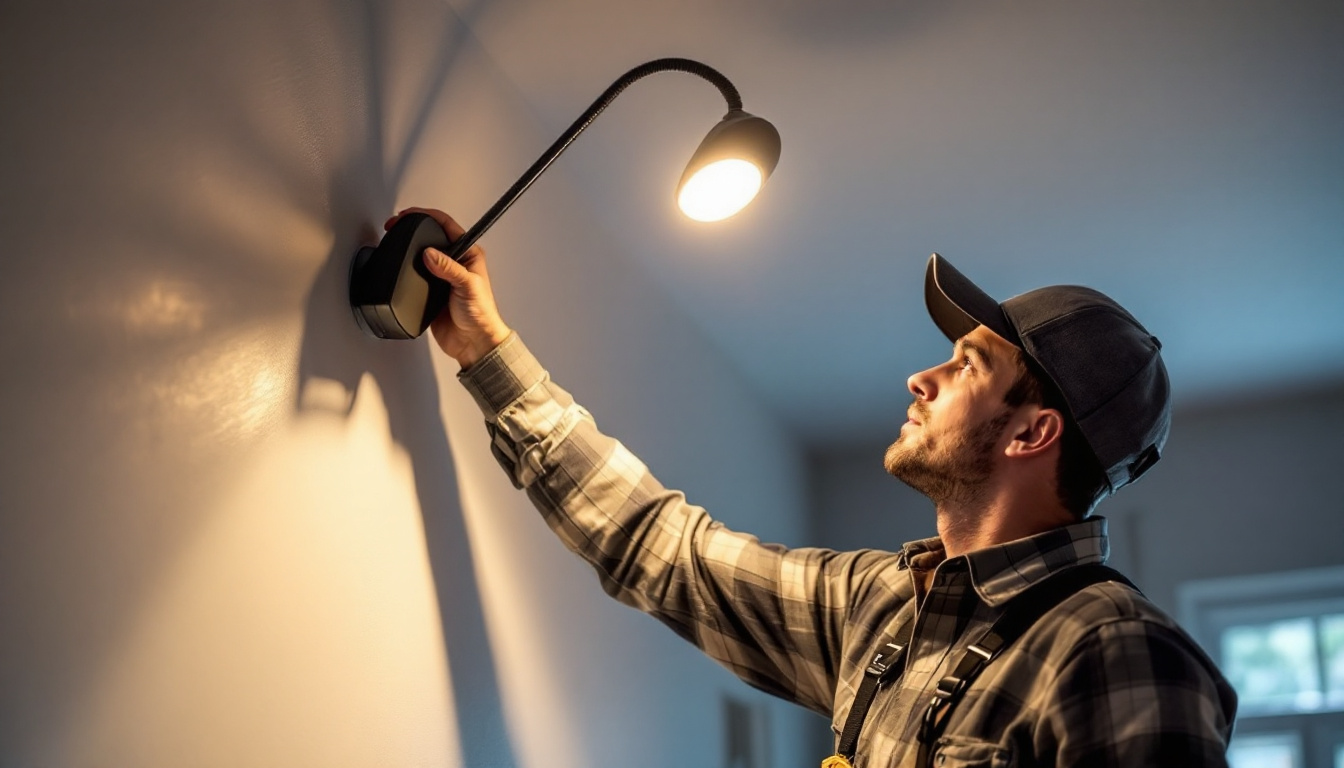

In the ever-evolving world of lighting solutions, gooseneck wireless operated lights have emerged as a versatile and practical choice for many lighting contractors. These lights not only provide excellent illumination but also offer flexibility in design and placement. For contractors looking to enhance their offerings, understanding how to choose the right gooseneck lights is essential. This guide will delve into the key factors to consider, the benefits of these lights, and tips on installation and maintenance.
Gooseneck lights are characterized by their flexible necks, allowing for adjustable positioning. When paired with wireless operation, these lights become even more user-friendly, enabling remote control and ease of installation. This section will explore the various features and advantages of gooseneck wireless lights.
One of the standout features of gooseneck wireless lights is their adaptability. The gooseneck design allows for precise positioning, making it easy to direct light where it’s needed most. Additionally, wireless operation eliminates the need for complex wiring, reducing installation time and labor costs.
Many models come equipped with energy-efficient LED technology, which not only reduces energy consumption but also extends the lifespan of the light. This is a significant advantage for contractors who seek to provide sustainable solutions to their clients. Furthermore, some gooseneck lights offer customizable color temperatures, allowing users to select warmer or cooler light settings to create the desired ambiance, whether for a cozy outdoor gathering or a bright work environment.
Wireless operation offers numerous benefits, particularly in terms of convenience and flexibility. Without the constraints of traditional wiring, contractors can install lights in a variety of locations, including areas that may be difficult to access. This flexibility is especially useful for outdoor settings or temporary installations.
Moreover, wireless lights can often be controlled via smartphone apps or remote controls, allowing users to easily adjust brightness levels or turn lights on and off from a distance. This feature enhances user experience and can be a selling point for contractors looking to differentiate their services. Additionally, many wireless gooseneck lights come with built-in timers and motion sensors, providing added security and energy savings by ensuring that lights are only activated when needed. This combination of smart technology and user-friendly design makes them an attractive option for both residential and commercial applications.
When selecting gooseneck wireless lights for projects, several factors must be considered to ensure the right fit for specific applications. Understanding these considerations will help contractors make informed decisions that meet their clients’ needs.
Light output, measured in lumens, is a critical factor when choosing gooseneck lights. The desired brightness will depend on the application; for instance, a decorative outdoor space may require softer lighting, while a workspace may need brighter, more focused illumination.
Color temperature is another important aspect to consider. Measured in Kelvin (K), it affects the ambiance of a space. Warmer temperatures (around 2700K-3000K) create a cozy atmosphere, while cooler temperatures (4000K and above) provide a more modern and energetic feel. Contractors should discuss these options with clients to determine the best fit for their projects. Furthermore, the choice of color temperature can influence not only the aesthetic appeal but also the functionality of the space. For example, in a retail environment, cooler lighting can enhance product visibility and appeal, while in residential settings, warmer tones may promote relaxation and comfort.
For wireless lights, battery life is a crucial consideration. Contractors should evaluate how long the lights can operate on a single charge and the time required to recharge them. Some models offer solar charging options, which can be advantageous for outdoor installations, providing a sustainable energy source.
Additionally, it’s important to consider the availability of replacement batteries or charging accessories. Ensuring that clients have easy access to these components can enhance satisfaction and reduce potential maintenance issues down the line. Moreover, advancements in battery technology mean that some gooseneck lights now come with smart features, such as energy-saving modes that extend battery life or indicators that alert users when the battery is low. This can be particularly beneficial in applications where consistent lighting is essential, such as in security lighting or for illuminating pathways.
Given that many gooseneck lights are used outdoors, durability and weather resistance are paramount. Look for lights with high IP ratings, indicating their ability to withstand dust and moisture. Materials such as aluminum or high-grade plastics are often preferred for their resilience against the elements.
Contractors should also consider the warranty offered by manufacturers. A longer warranty period can provide peace of mind, indicating that the manufacturer stands behind the quality of their product. Additionally, it’s wise to research customer reviews and ratings to gauge real-world performance, as this can reveal insights into how well the lights hold up over time under various weather conditions. Some premium models even incorporate features like UV resistance to prevent fading and corrosion, ensuring that the aesthetic appeal remains intact for years, regardless of exposure to harsh sunlight or rain.
Proper installation is key to maximizing the performance and longevity of gooseneck wireless lights. This section outlines essential tips for ensuring a successful installation process.
Before installation, it’s important to carefully plan the location of the lights. Consider factors such as the purpose of the lighting, the surrounding environment, and the desired aesthetic. For example, lights used for signage should be positioned to provide maximum visibility, while decorative lights may be placed to enhance the overall ambiance.
Additionally, take into account the reach of the wireless signal. Ensure that the lights will be within range of the control device to prevent connectivity issues. It might also be beneficial to conduct a site survey to identify any potential obstructions, such as trees or buildings, that could interfere with the wireless signal. This foresight can save time and effort during the installation process, ensuring that the lights function optimally right from the start.
Each gooseneck wireless light model will come with specific installation guidelines provided by the manufacturer. Adhering to these instructions is crucial to ensure safety and optimal performance. This includes following recommendations for mounting heights, angles, and any necessary adjustments to the gooseneck itself.
In some cases, contractors may need to use additional mounting hardware or brackets to secure the lights properly. Ensuring that the installation is stable will help prevent damage and maintain the integrity of the lighting solution. Furthermore, it’s wise to familiarize yourself with the specific features of the model being installed, such as dimming capabilities or color temperature adjustments, which can enhance the overall functionality and aesthetic appeal of the lighting setup.
After installation, it’s essential to test the lights to ensure they function as intended. Check the wireless connectivity and make any necessary adjustments to the positioning of the gooseneck to achieve the desired lighting effect.
Encourage clients to provide feedback on the lighting performance, as this can help identify any areas that may require further adjustment. A proactive approach to testing and adjustments can lead to higher client satisfaction and repeat business. Additionally, consider documenting the installation process and any adjustments made for future reference. This can be invaluable for troubleshooting any issues that may arise later and can serve as a guide for similar projects in the future. Keeping a detailed record not only enhances your professionalism but also builds trust with clients, showcasing your commitment to quality service.
Regular maintenance is vital for ensuring the longevity and efficiency of gooseneck wireless lights. This section highlights best practices for maintaining these lighting solutions.
Dust and debris can accumulate on the surface of the lights, affecting their performance and appearance. Regular cleaning with a soft cloth and mild detergent can help maintain their aesthetic appeal and functionality. For outdoor lights, it’s particularly important to remove any buildup that could obstruct the light output.
Contractors should advise clients on the best cleaning practices and frequency, depending on the environment in which the lights are installed. For example, lights in coastal areas may require more frequent cleaning due to salt and moisture exposure.
For battery-operated gooseneck lights, proper battery maintenance is crucial. Encourage clients to monitor battery levels and recharge them as needed. Providing clear instructions on how to replace batteries or troubleshoot charging issues can enhance user experience and reduce frustration.
In cases where solar-powered options are available, remind clients to keep the solar panels clean and unobstructed to maximize charging efficiency.
Conducting regular inspections of the lights can help identify any potential issues before they become significant problems. Check for signs of wear and tear, such as frayed wires or corrosion, and address these issues promptly to ensure continued performance.
Encouraging clients to report any irregularities or performance issues can foster a proactive maintenance approach, leading to longer-lasting lighting solutions.
Choosing the right gooseneck wireless operated lights requires careful consideration of various factors, including features, installation, and maintenance. By understanding the unique advantages of these lights and following best practices, lighting contractors can provide exceptional solutions that meet their clients’ needs.
As the demand for flexible and efficient lighting solutions continues to grow, gooseneck wireless lights represent a valuable addition to any contractor’s portfolio. With the right approach to selection, installation, and maintenance, contractors can enhance their service offerings and ensure client satisfaction for years to come.
In a competitive market, staying informed about the latest trends and technologies in lighting will empower contractors to make informed choices and deliver outstanding results. Embracing innovations like gooseneck wireless operated lights can set contractors apart, ensuring they remain leaders in the lighting industry.
Ready to elevate your lighting game with the most efficient gooseneck wireless operated lights? Look no further than LumenWholesale, where we provide contractors with superior, spec-grade lighting products at unbeatable wholesale prices. Say goodbye to inflated markups and hello to high-quality lighting that meets the highest industry standards. With our hassle-free bulk buying and free shipping, you can trust that you’re getting the best value for your investment. Don’t compromise on quality or affordability. Discover wholesale lighting at the best value today and light up your projects with confidence and convenience.

Discover essential insights and tips for lighting contractors in this comprehensive guide.

Discover essential insights and professional tips for lighting contractors in our comprehensive guide on Mh Lamps.

Discover why LED troffers are a game-changer for lighting contractors.

Discover the key insights into motion lights outdoor installations that clients expect lighting contractors to master.
Get notified when NEW deals are released.
Optimize your budget with wholesale discounts.
Only top-quality, specification-grade lighting products.
No additional costs at checkout - what you see is what you pay.
We understand the unique needs of contractors.